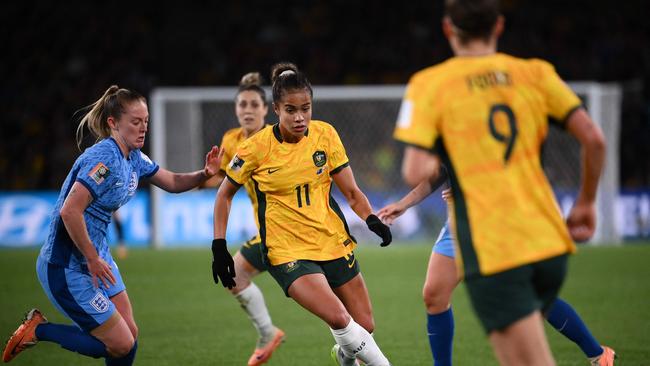The World Cup is almost over, so can Football Australia keep the momentum going?
The skill of the Matildas players is far more advanced than AFLW players but the harsh reality is Football Australia must now stand alone to provide for the game, writes Graham Cornes.
Opinion
Don't miss out on the headlines from Opinion. Followed categories will be added to My News.
It was a passionate but ultimately ill-fated love affair. We committed whole-heartedly to the romance, only to have our hearts broken. We should have known better.
The nation, the 11.15 million of us who tuned in, like star-crossed lovers were seduced by the theatre, the excitement, the talent and the promise of our Matildas. It wasn’t their fault. We put them on a pedestal and imparted crushing expectations which they couldn’t fulfil.
Realistically, reaching the semi-finals a World Cup tournament was beyond expectations, particularly considering that they had to beat France, the fifth ranked nation in the world to get there. But the Australian public made the Matildas national heroes and it happened almost overnight on the back of one of the most dramatic sporting contests we will ever see.
Nothing in world sport can live up to the drama, the excitement, the agony and the ecstasy of the penalty shootout and those who watched the spectacle of that Australia v France tie-breaker will never forget it. Like Cathy winning in Sydney or Australia II off Rhode Island, it is permanently etched into our sporting memories.
Of course, the soccer aficionados sneer at the suggestion that the Matildas would not reach the last four. They claim to have known all along that the Matildas would go deep into this FIFA’s Women’s World Cup.

It’s been a long time coming but it was always going to happen – they say. We just didn’t see it coming. It was a phenomenon that gathered an unstoppable momentum onto which we all wanted to jump – until it came to that crushing halt.
In truth, there was much to love about the Matildas. From the moment the tournament began, they conducted themselves impeccably. Never was there a hint of petulance or intolerance.
Never have young girls had such great role models. They gave of themselves willingly to an increasingly adoring public who responded as never before to a national team – be it men’s or women’s.
When Sam Kerr took off her playing shirt and handed over the currently most famous jersey in Australia to nine-year-old Zara Borcak, the whole country shared the young girl’s hysterical rapture. It was only one soccer shirt but it gave priceless promotion and goodwill for the game. Have we ever seen an AFL player give away a jumper after a big game?
This tournament will become a case study for sports marketers around the globe. How could an under-resourced women’s sport capture the imagination of the Australian public like no sport before?
We’ve had other big events. There was none bigger than the Sydney Olympic Games in 2000, but the country was not captivated as we have been in this FIFA Women’s World Cup. We watched Australia II come from behind to win the America’s Cup and while Bob Hawke, the Prime Minister of the day, exhorted people to take the day off to celebrate, the euphoria subsided pretty quickly. The average Aussie didn’t quite relate to the privileged elite of the New York Yacht Club.

Cathy Freeman held the nation spellbound while winning the 400m event in Sydney, but it was over in less than a minute. There have been great, gripping grand finals in all of our football codes. They were big in their local markets but none captivated the whole country.
However, we’ve had a whole tournament of women’s soccer across our two southern countries, New Zealand and Australia, which has been constantly in the news. And didn’t the news media respond.
Once the Matildas started to attract healthy crowds, the media soon realised the interest was unprecedented. No injury in the history of Australian sport has been scrutinised as much as Sam Kerr’s calf injury was. Mary Fowler’s black gloves became famous. Previously unknown players became household names overnight.
Fowler is the classic example. Black gloves aside, it impossible not to notice her as she covers the ground with a fluid athleticism and sublime touch on the ball. Her father is Irish, her mother is from Papua New Guinea and there is just a hint of a cultured British lilt in her Aussie accent. After Sam Kerr, she could be Australian women’s soccer’s next big thing.
Most importantly however, the Australian sporting public realised the talent of all the players. The quality of the women’s game and the skill of the players is far more advanced than, for instance, that of the AFLW players. Women’s AFL has come a long way but the general skill level is not commensurate to women’s soccer.
The Matilda’s glorious run in this FIFA Women’s World Cup officially ends of Saturday with the bronze medal decider but the magic has faded. The final is played on Sunday between Spain and England but do we really care? What remains now is the question of how to capitalise on this new-found popularity.

There are strident calls from the soccer world for more government support. There needs to be more investment in facilities and infrastructure – more grounds, more amenities for girls and women to change in. Salaries need to be higher in the women’s A-League competition.
They are all valid requests but how do you discriminate between the sports?
Our national netball team, the Diamonds, won the World Cup but we barely noticed and they were not rewarded financially. Our women’s hockey team have always been among the best in the world but are paid a pittance. For simply competing in this FIFA Women’s World Cup every player received $44,000 and each Matilda received at least $165,000 for reaching the bronze medal playoff.
That money comes from the governing body, FIFA, a fabulously wealthy organisation. It is still a lot less than the men earn and given the interest generated by the Matildas they were severely underpaid.
Unfortunately, there is a harsh reality to these demands for government and commercial investment. Once the World Cup is gone, Football Australia stands alone, faced with the responsibility of promoting and providing for the game.
Like the AFL which generates enough revenue to invest in its AFLW program, Football Australia must do the same. Government support should come in the way of investment in grounds and changerooms, but will that filter down to the young girls in the suburbs and the country?
The AFL’s investment in its women’s game saw an explosion of participation at junior level, but it was a long-term commitment. Can Football Australia make the same level of commitment to every young girl who has been inspired by the Matildas? That is the challenge.
We now won’t see the Matildas again until the end of October in Perth when they commence their Asian qualification for the Paris Olympics.
The question is: will absence make the heart grow fonder; or like that fleeting holiday romance will it become just a pleasant memory with no other substance?





